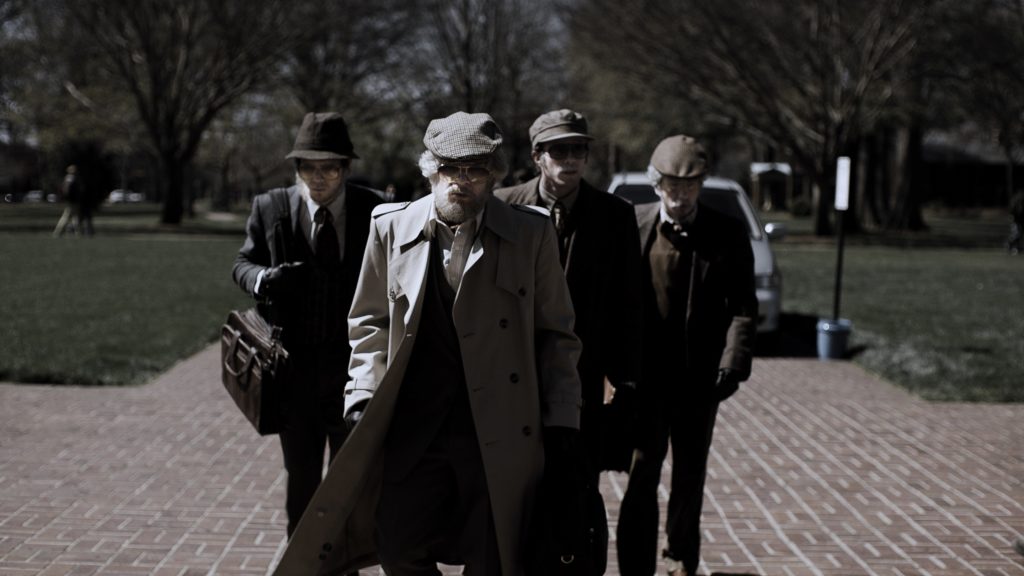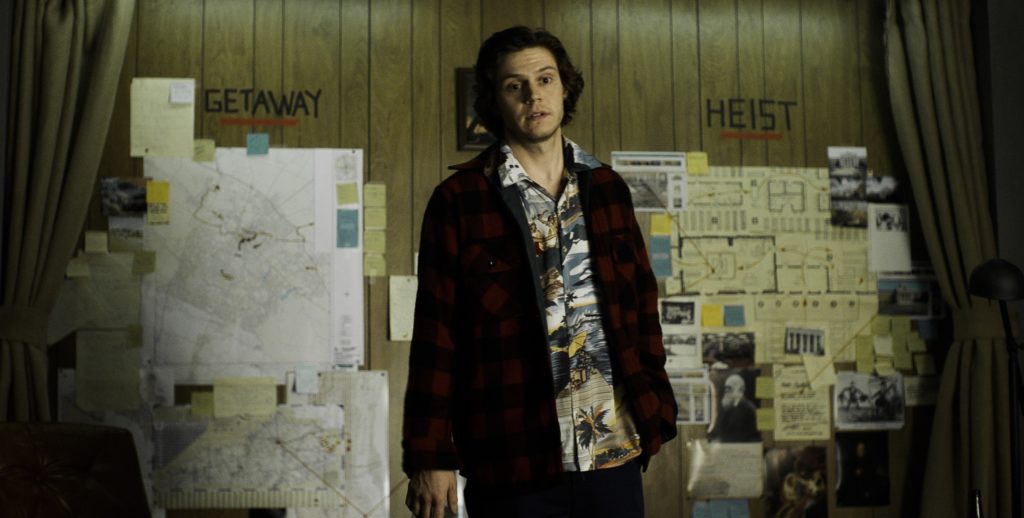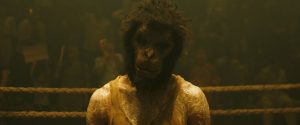Reviews include Irena’s Vow, The Beast, and Before I Change My Mind.
An Interview With: Bart Layton
June 21, 2018
In their minds, it’s Ocean’s 11. In reality, it’s Dog Day Afternoon.

Bart Layton’s American Animals dramatizes a bizarre yet true 2004 incident in which four university students planned to get rich by bumping off the special collections room of Kentucky’s Transylvania University. The targets of the heist were rare and priceless books, such as a first edition of Charles Darwin’s On the Origins of Species by Natural Selection, and four folios of John James Audubon’s Birds of America.
The students—Warren Lipka, Spencer Reinhard, Chas Allen II, and Erik Borsuk, played by Evan Peters, Barry Keoghan, Blake Jenner, and Canuck Jared Abrahamson—aren’t born criminals. They’re film geeks and frat boys informed by Guy Ritchie and Quentin Tarantino. The heist goes horribly wrong, but American Animals relishes the story of the imperfect crime.
American Animals infuses this true crime tale with the emotional weight of the consequences of the boys’ crime. Interviews with the real life subjects intersect with the dramatization of the incident. They are visibly affected by their crimes having grasped the long-term payout of their ill-conceived scheme. The interviews by the real life subjects consistently reframe one’s perceptions of their naïve dramatic counterparts. Special Collections Librarian, Betty Jean Gooch, the victim of a violently degrading assault during the heist, appears briefly for a devastating interview that leaves one shaken, while revered character actor Ann Dowd (Hereditary, The Handmaid’s Tale) recreates her scenes that are painful to revisit. The chorus of voices, both true and fictionalized, tells a compelling caper that leaves only victims in its botched payday.
Layton, who won the Filmmakers’ Award at Hot Docs 2012 for his riveting documentary The Imposter, once again creates a film that captivates through a playful feat of dexterous storytelling. Where The Imposter left one’s jaw hanging with its twists and reveals about a French-Algerian migrant who convinced an American family he was their long lost son only to become the object of a doubly-deviant duping, American Animals uses its dialogue of drama and documentary to reflect upon the lines seemingly ordinary citizens are willing to cross.
Pat Mullen spoke with Layton on the phone from London ahead of the Canadian theatrical release of American Animals discuss heist movies, hybrids, and the pleasures of finding a more truthful means to tell “true” stories.
Pat Mullen: How did you first discover the story of the American animals?
Bart Layton: I first found a news article when I was on a transatlantic flight. I picked up a magazine and there was the story. I found it intriguing on a number of levels, not least because of who the perpetrators were. They were these rather unexpected, fairly privileged young men with plenty of opportunities. They were from supposedly from good homes and fairly well educated. We reached out to them while they were some way into their prison sentences and we then began a correspondence back and forth. It was mainly letters and the occasional emails, and that was what brought me to it. What they had to say in their letters took the story from a good caper to something much more than that. To me, it seemed to speak to a current preoccupation, not just amongst millennials now. People feel this desperate need to be interesting and leave a mark on the world.
I really like how the film includes the interviews with the parents and with BJ, the librarian. Did you have much trouble securing the participation of subjects outside the four students? It must have been painful for some of them to revisit this chapter.
I don’t think anyone was desperate to revisit it. Most of the people involved, including the real guys and obviously BJ and the parents, were all very much of the mind that this wasn’t a story they wanted brought back into their lives. I think they weren’t sure of how the story was going to be presented. That’s something that we’re very familiar with as documentary makers—the longer process of winning trust and explaining what our vision for the film is going to be. The more they understood that, the more they were willing to participate. BJ took a year—or two, really—of regular communication. I think when she finally understood what it was I wanted to do, she agreed that she should have a voice in it.

I understand the four actors playing the students were instructed not to meet their real life counterparts. Can you elaborate on that strategy? Often meeting a real life counterpart seems like the process of making a film based on a true story.
I shot the interviews first and based the script largely around the interviews. The reason why I didn’t want the cast and the real guys interacting was that so much time had passed. The guys were a decade older—12 or 13 years older—than they were when the incident happened and most of that time had been spent in prison. They were different people. I wanted the actors to come at it without any sense of kind of obligation. I felt that they needed to find their own versions of these characters and be able to understand them.
And, of course, these guys are very likable. They did a very misguided thing and they paid the price for it, but they are likable young guys. I didn’t want the actors spending a lot of time with the real guys and then have the characters control the way in which they were going to be portrayed by the actors. I didn’t want a situation on set where an actor might say to me, “I spoke to the real Spencer and he said it wasn’t like that.” It was really just for them to be completely liberated and to put themselves into those characters.
I love the way the film plays with those competing recollections and memories. When you arrived at points where there were contradictions, like the disagreement over the colours of the scarf that their contact in Europe was wearing, how do you decide whose story to use when the interviews don’t match up?
I think that’s just it: I didn’t decide which stories to use. I decided to use both of them. I wanted to introduce this idea of questioning the way stories become fictionalized. These guys are unreliable narrators. Memory is also unreliable and so by showing that there was more than one version, we’re sort of pulling the curtain back on the way in which stories get exaggerated and fictionalized. We’re inviting the audience to play along and understand what’s afoot. I think partly we’re treating the audience with a good deal of respect. We’re very familiar with stories which are based on true stories and yet, generally, I often feel like I’m getting a very Hollywood-ized version of a true story.
Right. And the act of the storytelling is part of the thrill.
Most true stories don’t fit neatly into a Hollywood movie structure. This story was so outrageous and outlandish that I didn’t even feel it needed a huge amount of exaggeration. So, partly, I wanted the audience to be constantly reminded that what they’re watching is really a ‘true’ story in the real sense of the word. When people’s versions don’t add up, we’re not choosing the sexiest version. We’re showing that these things are at odds. Can we be sure that anyone is telling the truth? The whole film is about finding a new way of telling a true story.
With the Hollywood aspect, the four characters watched heist movies as part of their research. Did you do the same for the dramatization? We get the heist played twice in the film: first as a stylish Ocean’s Eleven-y caper when they’re planning it, and then the later one that’s more Asphalt Jungle—gritty and messy.
We had an expression when we were shooting: “In their minds, it’s Ocean’s Eleven. And in reality, it’s Dog Day Afternoon.” I watched a lot of the heist movies that we’re all familiar with. I gravitate towards the 70s’ ones—I used references to Taking of Pelham One Two Three; Dog Day Afternoon was a big one for me just in terms of the realism; Ocean’s Eleven, which they were kind of riffing on and were inspired by to an extent. And then The Killing, which you see a reference to in the movie, and Asphalt Jungle—the kind of combination of the more classical films, but also films like The Thomas Crown Affair. It’s a mixture of fantasy, the slick gentlemen criminals, which they are kind of acting out. They are lost in a fantasy of their own creation. When it comes time to cross this line, you see the wheels come off and we’re thrust into something that feels much more like documentary realism.
American Animals is like the flip side of The Imposter. With The Imposter, dramatic re-enactments complement and further the documentary interviews, and then American Animals has fewer interviews that punctuate the greater dramatic narrative and complicate our perspectives. How did that process evolve in choosing the right balance?
I’m glad you made that observation. It’s exactly a kind of inversion of The Imposter. With The Imposter, the documentary interviews drive the narrative and character, and with this one the other way round. The documentary scenes perform a very, very different job. It was really an experiment that I wanted to explore. Nothing is impossible in movie terms. A lot of people will preach a set of rules, which aren’t really rules. I think audiences are ready for a movie which is a little more honest in terms of the way in which it presents the process, so that was always the intention—that and being a bit cynical after watching movies that start with “inspired by true events” and give you pictures of the real people as the credits roll. I thought there has to be another approach which is greater than the sum of the parts—a visceral engagement.

It really seems that true crime has been central to the growing popularity of documentaries. Is there any reason why you think that might be?
I think it’s something that people are endlessly fascinated by. But, if you look at the documentaries that are doing very well at the moment, they’re RBG and Won’t You Be My Neighbor?. We have another feature doc coming out that my company produced called Three Identical Strangers [about triplets reunited at university after being separated at birth]. Those films aren’t true crime stories. I think it’s really about great stories. Yes, The Imposter was one of those, but crime is popular in the movies because most of us just won’t go there. That’s what American Animals is about: most of us will never cross that line into criminality. There can be something exciting about vicariously experiencing that world through characters. What happens in American Animals is that these young men were not cut out for the criminal life and had no experience with it. They paid the cost for it and were almost destroyed by it, even to this day.
Right. It’s really about the consequences of their actions. Today with the social media and even with people, world leaders, present themselves, many actions are removed from the consequences.
If it were just about the heist, I would have never wanted to make the movie. For me, it’s relevant and I think your point is a good one about people being removed from the consequences of their actions. More than that, I think it’s about the increasing pressure not to be average. Being average seems like something illegal. We inhabit a world where we’re under huge pressure to be somebody, to leave a mark and be remarkable. That’s what average means: it’s the mean. Some of us will have higher status, some of us will have a lower status, but the rest of us will just be average. Part of it is social media; another part is this shift towards a more individualistic culture. We are massively distracted by the urgent need to be somebody. The ad line on the poster is not about crime. It says, “Nobody wants to be ordinary.” That is a very big motivator—and particularly with people who are privileged enough to get to worry about whether they’re going to be important.
American Animals opens in Toronto on Friday, June 22 at TIFF Lightbox.



